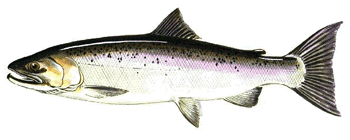Back to Previous Page
COHO (SILVER) SALMON

At-a-Glance
- Scientific Name: Oncorhynchus kisutch
- Found in Illinois: Lake Michigan
- State Average: 10-12lbs
- State Record: 20 lbs/9 oz (1972)
- Best Lures: large silver flatfish, silver spoons, lures with lights
Trolling the Great Lakes for salmon and trout in the early hours before dawn is popular among Lake Michigan anglers. Coho salmon can also be caught casting from shore until the weather warms up in June. After that, they head toward the cooler, deeper water.
Illinois anglers can expect to catch salmon from shore, off piers, and out in the lake by trolling with a boat. Charter boat service from Chicago may be available. Boat fishermen are cautioned to use adequate sized boats and motors when fishing as Lake Michigan can be very dangerous. Strict compliance with the Illinois Boating Act is essential. Important items to have aboard a boat include life preservers, fire extinguishers, portable marine band radio, a compass, and an auxillary or extra outboard motor. Daily weather reports and storm warning information is a prerequisite to fishing by boat.
Salmon have a tendency to deteriorate fast after they are caught. Therefore, the angler should immediately remove the gills and internal organs. The quality of the flesh will also be improved by placing the cleaned fish on ice.
Habitat: Freshwater salmon were introduced into the Great Lake system as early as the late 1800s. The main types are Chinook, Coho, Pinks, Kokanee (Sockeye), and two strains of Atlantic salmon.
It is well documented now that this first stocking of coho salmon made by Michigan turned out to be an outstanding success. This stocking consisted of about 850,000 salmon, eighteen months old, which were placed in three tributary streams to the Great Lakes in the spring of 1966. The first authenticated report of salmon being taken on hook and line in Illinois waters came on March 21, 1968.
Feeding and Habits: In Lake Michigan, the adult coho diet is dominated by small alewife.
Reproduction: In Lake Michigan tributaries, cohos typically spawn on shallow gravel nests (redds) in October and November. Eggs hatch in April, and juvenile cohos (parr) remain in streams for one year before turning silver (smolting) and heading for the big lake. Most coho spend 18 months feeding in Lake Michigan before returning to natal streams, but some precocious males (jacks) spend only six months in the big lake.



